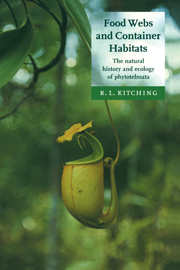Book contents
- Frontmatter
- Contents
- Preface
- 1 Introduction
- Part I The container flora, fauna and environment
- 2 The container flora
- 3 The container fauna
- 4 The phytotelm environment
- Part II Methods and theories
- Part III Patterns in phytotelm food webs
- Part IV Processes structuring food webs
- Part V Synthesis
- Annexe: The phytotelm bestiary
- References
- Index
4 - The phytotelm environment
The container milieu
Published online by Cambridge University Press: 26 August 2009
- Frontmatter
- Contents
- Preface
- 1 Introduction
- Part I The container flora, fauna and environment
- 2 The container flora
- 3 The container fauna
- 4 The phytotelm environment
- Part II Methods and theories
- Part III Patterns in phytotelm food webs
- Part IV Processes structuring food webs
- Part V Synthesis
- Annexe: The phytotelm bestiary
- References
- Index
Summary
The ecologist who delves deep within a large tree hole will find that there is a close-packed layer of sediment at the bottom of the deeper holes which, when disturbed, emits pungent bubbles of hydrogen sulphide. In other holes the surface may be glazed with an oily film derived from particular fruits or even animal cadavers which happen to have come to rest within them. In one upper pitcher of Nepenthes rafflesiana in Brunei, Charles Clarke and I measured the pH as 1.5 – the tiny water body was greasy to the touch but still contained mosquito larvae! Some bamboo cups or leaf axils contain litres of water: in other cases, only a few cubic centimetres of liquid. And at a different level I once spent a whole day searching in cool temperate rainforest in western Tasmania to find but two water-filled tree holes, whereas a month later in Borneo I encountered about a dozen in a couple of hours' walk. The environment at both macroscales and microscales presented to organisms which inhabit phytotelmata may be extreme or highly variable or both. This chapter examines aspects of the physical and chemical environment presented by phytotelmata.
Foodwebs made up of animals feeding directly or indirectly upon detritus within water bodies of phytotelmata of whatever kind live within a particular physical and chemical context.
- Type
- Chapter
- Information
- Food Webs and Container HabitatsThe Natural History and Ecology of Phytotelmata, pp. 57 - 90Publisher: Cambridge University PressPrint publication year: 2000



